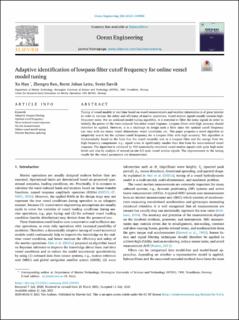| dc.contributor.author | Han, Xu | |
| dc.contributor.author | Ren, Zhengru | |
| dc.contributor.author | Leira, Bernt Johan | |
| dc.contributor.author | Sævik, Svein | |
| dc.date.accessioned | 2021-07-27T08:46:51Z | |
| dc.date.available | 2021-07-27T08:46:51Z | |
| dc.date.created | 2021-07-26T12:15:32Z | |
| dc.date.issued | 2021 | |
| dc.identifier.citation | Ocean Engineering. 2021, 236, . | en_US |
| dc.identifier.issn | 0029-8018 | |
| dc.identifier.uri | https://hdl.handle.net/11250/2765329 | |
| dc.description.abstract | Tuning of vessel models in real-time based on vessel measurements and weather information is of great interest in order to increase the safety and efficiency of marine operations. Vessel motion signals usually contain high-frequency noise. For an unbiased model tuning algorithm, it is essential to filter the noisy signals in order to identify the power of the wave-induced first-order vessel response. Lowpass filters with high accuracy should therefore be applied. However, it is a challenge to design such a filter since the optimal cutoff frequency can vary with sea states, vessel dimensions, vessel conditions, etc. This paper proposes a novel algorithm to adaptively search for the optimal cutoff frequency for a lowpass filter with high accuracy. The algorithm is fundamentally based on the facts that the vessel naturally acts as a lowpass filter and the energy from the high-frequency components, e.g., signal noise, is significantly smaller than that from the wave-induced vessel response. The algorithm is validated by 500 numerically simulated vessel motion signals with quite high noise levels and also by analysis of several on-site full-scale vessel motion signals. The improvements to the tuning results for the vessel parameters are demonstrated. | en_US |
| dc.language.iso | eng | en_US |
| dc.publisher | Elsevier Ltd. | en_US |
| dc.relation.uri | https://doi.org/10.1016/j.oceaneng.2021.109483 | |
| dc.rights | Navngivelse 4.0 Internasjonal | * |
| dc.rights.uri | http://creativecommons.org/licenses/by/4.0/deed.no | * |
| dc.title | Adaptive identification of lowpass filter cutoff frequency for online vessel model tuning | en_US |
| dc.type | Peer reviewed | en_US |
| dc.type | Journal article | en_US |
| dc.description.version | publishedVersion | en_US |
| dc.source.volume | 236 | en_US |
| dc.source.journal | Ocean Engineering | en_US |
| dc.identifier.doi | 10.1016/j.oceaneng.2021.109483 | |
| dc.identifier.cristin | 1922659 | |
| dc.relation.project | Norges forskningsråd: 237929 | en_US |
| dc.description.localcode | This is an open access article distributed under the terms of the Creative Commons CC-BY license, which permits unrestricted use, distribution, and reproduction in any medium, provided the original work is properly cited. | en_US |
| dc.source.articlenumber | 109483 | en_US |
| cristin.ispublished | true | |
| cristin.fulltext | original | |
| cristin.qualitycode | 1 | |

